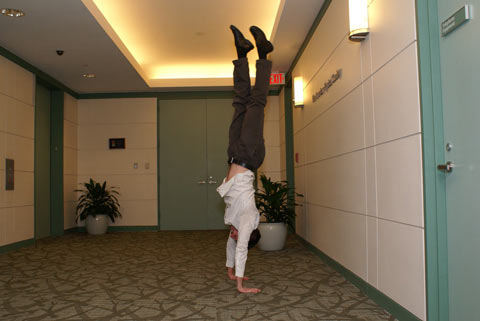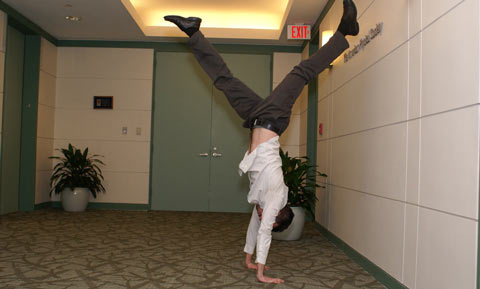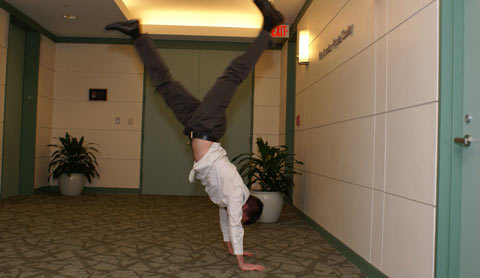How to Do a Handstand with Physics
Physics can trace many of its roots back to Ancient Greek philosophers such as Plato, Socrates, and Democritus. For instance, Democritus and his teacher Leucippus pioneered ancient atomism – the belief that the world consisted of tiny, indivisible objects.
Later Greek thinkers expanded on these pre-Socratic ideas in attempts to explain concepts like physical motion and teleological growth, such as the eventual growth of an acorn into an oak tree.
These early philosophers gained an appreciation for much more than these nascent physical theories, however. In addition to being a great thinker, Plato seemed to be a big fan of exercise as well:
“Lack of activity destroys the good condition of every human being while movement and methodical physical exercise save it and preserve it.”
Most likely, Plato was referring to gymnastics — a sport developed in ancient Greece that endures in today’s modern Olympic Games. Modern physics can help explain why Olympic athletes can perfect (or, in the case of your humble physics writer, attempt to perfect) the varied moves and static positions found in gymnastics.
In honor of this ancient intersection, today we’ll analyze the physics behind one of the most basic gymnastics maneuvers: the handstand. With a little physics help, you can perfect this move.

Center of Mass
Perfecting your handstand requires an acute awareness of your center of mass – a concept that pervades the physics world. Basically, an object's center of mass is the average weighted position of all of the tiny masses that comprise the object. A twelve-inch ruler’s center of mass, for instance, should lie right in the middle at the six-inch mark. Using a body’s center-of-mass greatly simplifies calculations because it allows physicists to assign a single point for a 3-dimensional object's location.
You may have run into center of mass calculations in the realm of astrophysics. Although it appears that the Earth revolves around the Sun’s center of mass, both of these bodies actually revolve around a common center of mass called the barycenter that lies between the sun and the Earth. Because the sun is much more massive than Earth, the barycenter lies ever so slightly outside the center of the sun.
Perfecting Your Technique
We can apply this concept to achieve the most stable inverted position for our handstand. For humans, our center of mass usually lies right around the navel, and you’ll want to keep that center of mass directly above your wrists. To maintain this position, you’ll want to keep your body rigid and straight; there should be a straight line connecting your hips and wrists (no arched backs).
As you kick up into the handstand, try to get your center of mass directly over where you’re holding your weight. Once inverted, there are a couple ways to keep your center of mass where it should be. When learning handstands, it’s often easier to keep your legs spread apart, as seen below. As long as your legs extend at the same angle from your hips, their equal masses will cancel out, and your center of mass will remain near your navel and over your wrists.

Keeping your legs spread makes handstands easier for most. You'll want to keep your body in an otherwise straight line from your wrists to hips, however. Avoid arching your back.
Eventually, you’ll want to work on straightening your legs so that a perfect line runs from your ankles to your wrists. Holding this straight body position not only looks more aesthetically pleasing, but it will also make longer holds easier.
The Inverted Pendulum
Inevitably, your body will shift slightly while holding the position, requiring you to make small adjustments to your center of mass. To make these adjustments, never sacrifice your straight body form. Instead, you can rock back and forth on your fingers and palms, acting like an inverted pendulum.
If you start to fall forward, press hard into your fingertips, and your body will oscillate back toward an upright position. Inversely, if you start falling backward, you need to push into the base of your hand at the palm.
In the first image at the top of the article, you can see my body tipping a little bit forward. At that point, I should be pressing into my fingertips to oscillate back to a straighter position.
The key to this balancing act is making your oscillations very small. If you start swinging back and forth too much, your momentum will carry you too far and force you to abandon the handstand.

An example of poor handstand form: an arched back with a center of mass well behind the wrists. Needless to say, I didn't hold that position for long.
Other than physics, all you’ll need is plenty of practice. At first, you can use a wall to support one of your legs when you kick up to the handstand. Try keeping your back straight, legs spread, and one leg barely resting against the wall.
From there, you can work on holding a freestanding handstand with your legs spread. Finally, try to bring your legs together and point your toes to the sky. Just remember to keep your core muscles tight, body straight, and center of mass over your wrists. Good luck!
Other Resources
-Brian Jacobsmeyer














